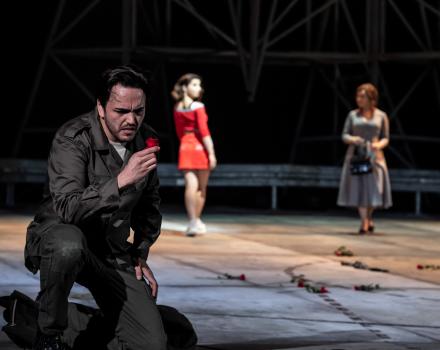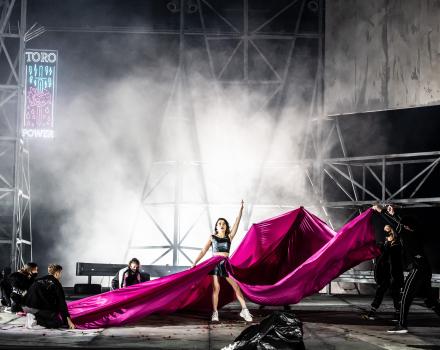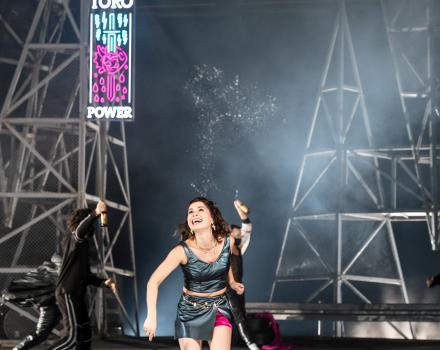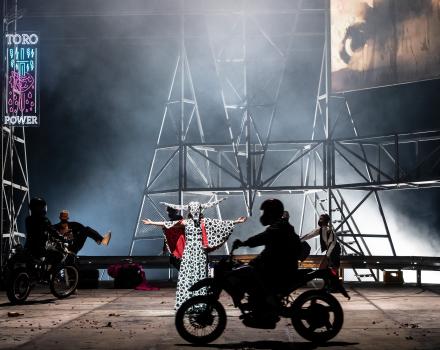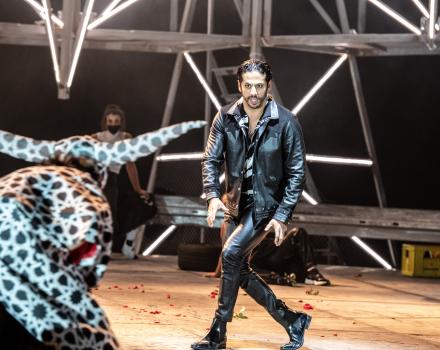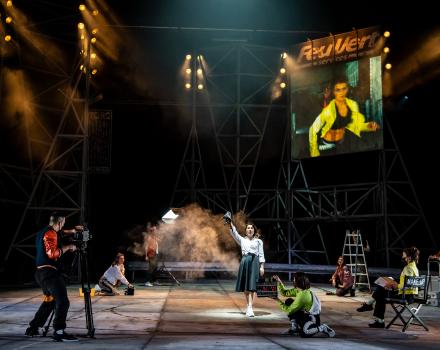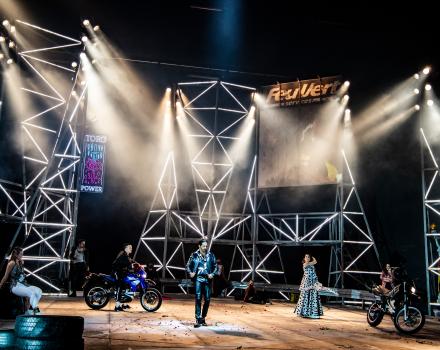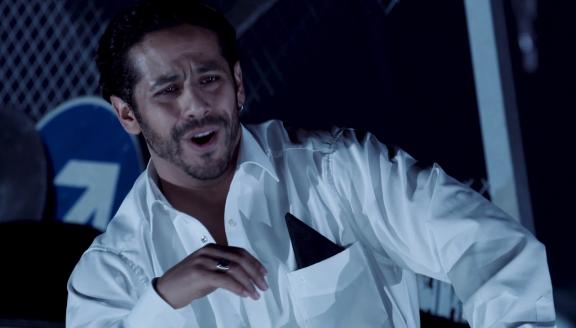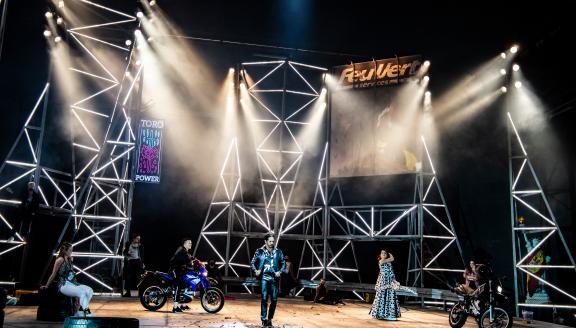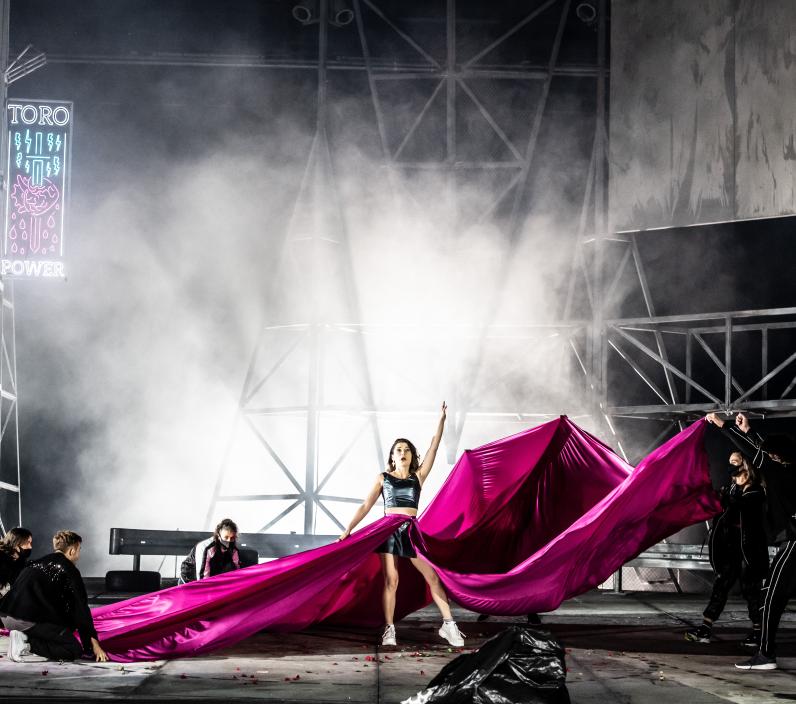

Carmen

Here is a Carmen that addresses the timeless question of whether we are able to control our own desires.
With equal parts danger and desire, Carmen is an intoxicating cocktail that never fails to excite the senses. Staatsoper Hannover offers this new staging by house director Barbora Horáková in an arrangement for chamber ensemble by Marius Felix Lange. It promises to tackle head on the topicality of Carmen who challenges stereotypical role models. Staatsoper Hannover makes no compromises with questions of freedom and OperaVision salutes their courage to create sensuality on stage and to offer us all a livestream in challenging times.
Cast
|
Carmen
|
Evgenia Asanova
|
|---|---|
|
Don José
|
Rodrigo Porras Garulo
|
|
Micaëla
|
Barno Ismatullaeva
|
|
Escamillo
|
Germán Olvera
|
|
Frasquita
|
Mercedes Arcuri
|
|
Mercédès
|
Nina van Essen
|
|
Zuniga
|
Yannick Spanier
|
|
Dancers
|
Eleanor Freeman, Alice Gaspari, Chiara Viscido, Tommaso Bucciero, Patrick Michael Doe, Dominic McAinsh
|
|
Orchestra
|
Niedersächsisches Staatsorchester Hannover
|
| ... | |
|
Music
|
Bizet / Lange
|
|---|---|
|
Conductor
|
Stephan Zilias
|
|
Director
|
Barbora Horáková
|
|
Sets
|
Thilo Ullrich
|
|
Lighting
|
Sascha Zauner
|
|
Costumes
|
Eva-Maria Van Acker
|
|
Text
|
Henri Meilhac, Ludovic Halévy
|
|
Dramaturg / additional texts
|
Martin Mutschler
|
|
Sound
|
Maria Anufriev
|
|
Video
|
Sergio Verde
|
| ... | |
Video
The story
Few pieces of opera literature are as stirring as Carmen. The seemingly irrepressible energy that emanates from Bizet's masterpiece comes from many sources: from the melodic richness; from the harmonic flexibility that creates constant surprises by borrowing from (seemingly) Spanish music. And last but not least, the vivid contrasts with which Carmen and Don José talk past each other and thus never really come together. But why the misunderstanding of love leads to murder is also due to fatal role models. The fascination emanating from the Carmen figure, as well as the outrage at her brutal death, are at the beginning of the success story of this most famous of all operas.
The special requirements of the year 2020 in particular have made it necessary to put the Bizet original to the test: With a smaller cast, without choir and children's choir and with a reduced orchestra, the perception of the piece also changes. Based on Bizet, a musical theatre was invented that tightens the overall dramaturgy of the play, creates transitions where otherwise there would have been gaps, and thus puts the seemingly fateful encounter of the two main characters in a new light. The play is thus modernised: not only by exposing the emancipatory core of the material, but also by intensifying the explosive nature of its message. The piece may be reduced, but it has gained in sharpness, and thus in topicality.
Marius Felix Lange set up the score for 21 musicians with additional instruments such as vibraphone, marimba, contrabassoon and tuba and composed a new introduction and transitional music. Spoken and sung texts are organically integrated into the interplay of stage and orchestra pit. In this way, an overall musical-theatrical structure is created which strengthens the urgency of the core story. This core narrative is a dazzling fantasy of two characters who speak of love and mean something very different. But it is also the story of a brutal murder of a woman and how it could come about. José's view of the events 'back then in Seville' is coloured by nostalgia - and at the same time drenched in chauvinism, which ascribes to men an almost self-evident right to women. This is contrasted by Carmen's direct experience, who seems to have made her own pact with freedom. What does she mean when she says "freedom", what longings and fears are going through her mind?
Insights
Carmen is a world of its own
Dramaturg Martin Mutschler in conversation with stage director Barbora Horáková
You have often mentioned that Carmen is 'a world' for you. What do you mean by that?
I mean that the figure of Carmen can only be fed by her own deepest emotions, by personal experiences. There is no formula for embodying the character, for a singer it is a great challenge. As a director, I can show up paths, but the singer has to feel them.
Almost in contradiction to this, the figure of Carmen seems to me at first like a blank space in the piece that is difficult to define. Similar to Mozart's Don Giovanni, she seems to be more a principle than a living character. This may also have something to do with the history of the opera's reception, which has turned Carmen into a vamp, a femme fatale. How do you fill the above-mentioned blank?
I like the word principle: for me, Carmen is like a wave, whose shape you can guess, whose balance of power you can see, but whose nature you cannot predict - how salty or dangerous the water really is, whether it is cold or warm, you have to find out together.
You allude to the natural force of the figure ...
In the times of Bizet, Carmen stood for something that people were afraid of. Today, other things frighten us: that we no longer know what freedom is and where our own limits lie. I often have to think about the central question in Dostoyevsky's Brothers Karamazov: Is there still morality in a world where one can no longer believe in God? Where there are no more external barriers, the fear that would prevent you from crossing borders disappears.
But this freedom is not an external risk, but a fear of what is inside oneself. What is Carmen afraid of?
Maybe she is afraid of falling in love because she fears losing her love in the bond. But I believe that the character's spectrum is larger, and that has something to do with our reading: We exceed certain ideas that are commonly held about Carmen by showing a young, lively woman who is also struggling with the impossibility of social advancement.
Our production takes place - to quote Bruce Springsteen - in the 'darkness at the edge of town': it is about boundaries between social milieus, but also about places where our post-industrial civilization is fraying. The stage design shows parts of an abandoned stadium that was once part of a megalomaniacal representational architecture but is now only a ruin that bears witness to the failure of a long-gone future. Through the "darkness" in which things happen that 'downtown' only dreams about, this place also has the potential to function according to different laws than the illuminated centre of society. Where does your inspiration for this milieu come from?
I have always found abandoned stadiums fascinating: how they are given new life by the people who simply appropriate them. On the other hand, I was also inspired by those intermediate places that you sometimes see in photos from war zones: Soldiers stationed in Syria play football between the ruins with the children of the locals. A child and a soldier playing ball together: it suddenly gives a very warm feeling to the bare, destroyed places. Another inspiration was the Spanish singer Rosalía. She grew up on the outskirts of Barcelona in a slab ¬ built not far from a Seat¬ and Chupa Chups¬ factory. In interviews, she describes what it meant for the teenagers to transform these places into a big shadow play at night. Playing to live, to survive - that is where dance comes into play. Rosalía discovered a very old tradition for herself in flamenco and was able to transform it into something new and trendy.
Pop culture uses this industrial dress-up and gives it its very own glamour in a crazy act of social empowerment. This can also be seen in Rosalía's videos, where car parks and port facilities are suddenly transformed into stages - and in the process, common visual worlds are undermined by a novel combination of symbols. I see parallels to the lusty contrast that already exists in Bizet's Carmen: Drama, lust and play are already seamlessly juxtaposed in the genre of the Opéra comique, differences simply are not levelled out. This brings Bizet much closer to the reality of people's lives, for what is realism if not the harsh simultaneity of irreconcilable worlds?
Take Carmen's 'Chanson bohémienne': here you can feel an incredible lightness and freedom under which danger lurks - and both lightness and freedom are extreme. I think that's why Carmen is so popular: the melodies are not only not so well known because they are beautiful. The 'Habanera' is also a song of seduction and at the same time tells of the danger of love, where you can also burn yourself.
The additional dancers have given us the opportunity to replace the missing choir on stage with a smaller collective. These dancers now perform as a chorus themselves, as corps de ballet - and give the audience a real show.
It was important to me that our arrangement does not become a kaleidoscope of snapshots, but a story with beginning and end. Bizet's Carmen begins as an operetta and ends as a drama - so the piece must also show Carmen's passion for dance. After all, life itself is a constant show - we film ourselves, want to show ourselves beautifully and feel alive.
Throughout the play, José seems to say to Carmen: 'Tell me how to live!' Because she knows, and he could learn from her. But he destroys his chance of living by killing her. She owes him the answer because it is too late: he has destroyed everything. All we hear is her breathing. At the same time, however, her breathing is also an answer to his question, because it means: "Here, in the moment, one lives with every breath.“
Don José is actually too late with everything because he is hanging on to his past. He cannot look ahead. Carmen's tragedy, on the other hand, is that she is afraid to look both backwards and forwards; her refuge is to live only in the moment. What would a future look like for her? One cannot live from day to day. Again, it is all a question of balance. Living is unpredictable. How do we deal with it?
Gallery

